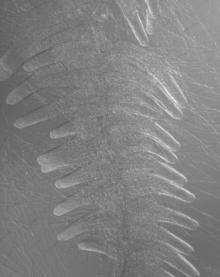Scientists discover how certain hormones control aspects of root branching in plants
.jpeg)
(PhysOrg.com) -- Roots are the most underestimated parts of a plant, even though they are crucial for water and nutrient uptake and consequently growth. In a world of changing water availability and an ever-increasing human population, it will therefore be crucial to understand how root development is controlled in plants. Scientists at the Max Planck Institute for Developmental Biology in Tübingen, Germany, now described that the plant hormone auxin together with an increased cell cycle activity leads to a boost in root branching in the common thale cress Arabidopsis thaliana.
In addition, they showed that two proteins that are crucial for embryo development also play a critical role in root branching. These results could be used to raise plants that are fast-growing even in dry and nutrient-poor soils (PNAS, January 25 - 29, 2010).
About two hundred years ago, Thomas Robert Malthus predicted that sooner or later a continuously growing world population would be confronted with famine, disease, and widespread mortality. Today, the world is facing the major challenge of providing food security for an ever-growing world population, which will require an increase in food production that is exceeding the one from previous decades. To achieve this, a new green revolution is needed, which will result in high yield plants that grow in soils with very low potential.
Astoundingly, when one thinks about a plant, mainly flowers, leaves, fruits and seeds come to mind, but one rarely considers the roots - the part hidden below the soil - as vital parts. Nevertheless, the root system, which consists of a main root that makes lateral branches, is without doubt the most important part of the plant, since without roots, a plant cannot take up nutrients and water, cannot stay upright, and cannot interact with advantageous symbiotic organisms.

Building on previous observations, a group of scientists in the Department of Gerd Jürgens at the Max Planck Institute for Developmental Biology, together with scientists in Belgium, described the necessity of combining increased cell cycle activity and auxin, which is one of the major plant hormones, to give rise to an increase in root branching. Their study object was the common thale cress Arabidopsis thaliana. In addition, they showed that two proteins that are crucial for embryo development also play a critical role in root branching. Furthermore, they could for the first time demonstrate that the response to the hormone auxin takes place in discrete, successive steps.
"This knowledge is an important step towards an improved and increased root system that can support the required increase in plant yield, which will guarantee food security and which will support the role of plants as an energy source", said Ive De Smet. "Specifically, since water, nitrogen and phosphorus availability are often limiting, a root system that is able to more efficiently take up and store nutrients will allow the use of less fertilizer and will permit plants to survive in dry, less arable areas", the biologist added.
More information: Bimodular auxin response controls organogenesis in Arabidopsis. PNAS Early Edition, January 25 - 29, 2010, www.pnas.org/cgi/doi/10.1073/pnas.0915001107
Provided by Max-Planck-Gesellschaft


















